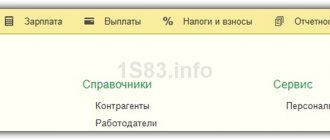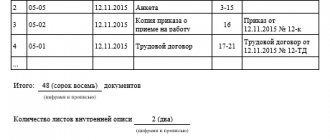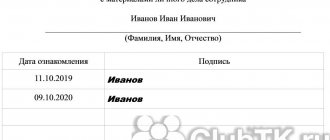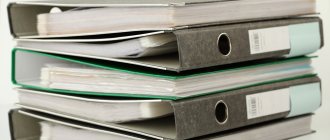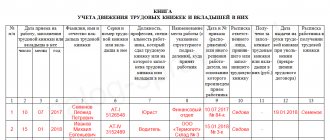General provisions
1.1. The archive is a structural unit of [full name of the enterprise indicating the organizational and legal form] and is part of the General Department.
1.2. To store Archive documents, an isolated non-residential premises with an area [in numbers and words] sq. m. is used. m, located on the [value] floor of the building at the address: [enter as required]. This room is equipped in accordance with established requirements.
1.3. The archive in its activities is guided by legislative and other regulatory legal acts of the Russian Federation and legal acts of the constituent entities of the Russian Federation that do not contradict them, as well as regulatory legal acts of the Federal Archival Service of Russia and these regulations.
back to contents
Approximate archive regulations
__________________________ I APPROVED Name of the organization ________________________________ REGULATIONS Name of the position of the head of the organization __________ N _____ _________ _____________________ Signature Explanation of signature __________________ ________________________________ Place of compilation date About the archive 1. GENERAL PROVISIONS
1.1. In order to timely receive archival documents from structural divisions or other sources, compile them, ensure their accounting, safety, organization and use in accordance with current legislation and prepare for the transfer of documents for permanent storage in ______ “_____________”, an Archive is created.
1.2. The organization provides the Archive with the necessary premises, equipment and personnel.
1.3. The archive of documents of the organization (hereinafter referred to as the Archive) is an independent structural unit / is part of another structural unit.
1.4. The archive is directly subordinate to the head of the organization (the head of the documentation support department - depending on the organizational management structure).
1.5. The archive is headed by the manager, who is appointed to the position and dismissed from his position by order of the head of the organization on the proposal of the head of the personnel department.
A person with a higher professional education without requirements for work experience or secondary specialized education and work experience in office management of at least 2 years is appointed to the position of manager.
1.6. Head of Archive:
1.6.1. Heads the organization and management of archival affairs in the organization.
1.6.2. Ensures the reception, registration, systematization, storage and use of documents in accordance with the established procedure.
1.6.3. Supervises the work on compiling a reference apparatus that facilitates the recording and use of archival documents.
1.6.4. Provides methodological assistance in finding the necessary documents.
1.6.5. Instructs employees of structural units on the procedure for forming, preparing and submitting files to the archive.
1.6.6. Monitors the timely receipt of documents completed by office work into the archive.
1.6.7. Provides work on the examination of the value of archival documents, the formation of documents for permanent and temporary storage.
1.6.8. Supervises the work on compiling case inventories for transferring documents to state archives, drawing up acts on the destruction of documents whose storage periods have expired.
1.6.9. Monitors the condition of documents, the timeliness of their restoration, and compliance in the archive premises with the conditions necessary to ensure the safety of documents.
1.6.10. Organizes work on keeping records of document flow and the number of cases, issuing archival certificates based on the data available in archive documents.
1.6.11. Prepares prescribed reports.
1.6.12. Participates in the development of regulations and instructions for record keeping and archival management.
1.7. During the absence of the Archive Manager, his duties are performed by _______________, appointed by order of the Head of the Organization.
1.8. The structure and staff of the archive are determined by the organization's staffing schedule, depending on the volume and number of documents stored in the archive.
1.9 The archive in its activities is guided by:
1.9.1 Regulatory legal acts on record keeping and archiving organization.
1.9.2 Charter of the organization (Regulations on the organization).
1.9.3 Orders and instructions of the head of the organization.
1.9.4 Internal labor regulations.
1.9.5 Collective agreement.
1.9.6 These Regulations.
1.9.7 ______________________________________________________________.
1.10. Qualification requirements, functional responsibilities, rights, responsibilities of the head and other employees of the Archive are regulated by job descriptions approved by the head of the Organization.
1.11. The head of the Archive (the person performing his duties) has the right to sign documents sent on behalf of the Archive on issues within his competence.
1.12. In its activities, the Archive interacts with other structural divisions of the Organization, as well as, within its competence, with third-party organizations.
1.13. The work of the organization's archive is carried out on a planned basis.
The archive of the organization contains:
— work plan for the year;
— schedule for receiving cases into the organization’s archives;
— a schedule for transferring cases for permanent storage to the state archive, submitting annual sections of summary inventories of cases for consideration by the expert-methodological commission of the state archive or the expert-verification commission of the structural unit for archives and records management of the regional executive committee;
— passport of the organization’s archive.
1.14. The archive documents include:
— documents with a long-term (over 10 years) shelf life, generated during the activities of the organization’s structural divisions; documents necessary in practical activities; personnel documents;
— documents of permanent storage and on the personnel of predecessor organizations;
— documents of permanent storage and on the personnel of liquidated organizations directly subordinate to this organization;
— official and departmental publications;
— scientific reference apparatus for archive documents.
1.15. When there is a change in the head of the archive of an organization (the person responsible for the archive), a commission consisting of at least 3 people is appointed by order of the head of the organization. The acceptance and transfer of documents and files, scientific reference apparatus for them, accounting documents, as well as premises, inventory and equipment of the organization’s archive is formalized by an act.
1.16. Control over the activities of the archive is carried out by the head of the organization or his deputy.
2 MAIN TASKS
The objectives of the organization's archive are:
2.1. Completing the archive with documents.
2.2. Accounting and ensuring the safety of documents.
2.3. Ensuring the use of documents.
2.4. Preparation and transfer of documents for permanent storage in the state archive in cases established by acts of legislation of the Republic of Belarus.
2.5. Implementation of methodological guidance and analysis of the state of archival affairs and record keeping in subordinate (part of the system) organizations and organizations - sources of archive acquisition.
3 FUNCTIONS
In accordance with the main tasks, the archive is assigned the following functions:
3.1. Compiles and annually updates the list of organizations - sources of acquisition (for the consolidated archive).
3.2. Accepts for storage documents of structural divisions of the organization and organizations - sources of archive acquisition.
3.3. Takes into account documents and files accepted into the archive, maintains a set of accounting documents.
3.4. Classifies documents according to archival funds and archival collections (hereinafter referred to as funding) of documents and files accepted into the archive.
3.5. Ensures the safety of documents and files accepted into the archive, controls the conditions of their storage, and checks the availability of documents and files.
3.6. Compiles and maintains up-to-date scientific reference apparatus for documents stored in the archive.
3.7. Makes use of documents stored in the archive, issues information documents, copies of archival documents, copies of parts of archival documents at the request of organizations and citizens, provides documents to users for work in the reading room, issues files for temporary use to structural divisions of the organization and third-party organizations, keeps records and analysis of document use.
3.8. Participates in the work of the central expert commission (hereinafter - the CEC) or the expert commission (hereinafter - the EC) of the organization, provides methodological assistance in conducting an examination of the value of documents located in the structural divisions of the organization, in subordinate (part of the system) organizations and in organizations - archive acquisition sources.
3.9. Conducts an examination of the value of documents and files stored in the organization’s archive, draws up annual sections of consolidated inventories of files that are subject to storage, and acts on the allocation for destruction of documents and files that are not subject to storage, submits them for consideration by the Central Executive Committee (EC) of the organization and, in cases established by these Rules, other acts of legislation of the Republic of Belarus - the state archive, the structural unit for archives and records management of the regional executive committee or a higher organization.
3.10. Prepares and transfers documents for permanent storage to the state archive in cases and in the manner established by these Rules and other acts of legislation of the Republic of Belarus.
3.11. Submits to the structural unit for archives and records management of the regional executive committee or the state archive information on the composition and volume of funds stored in the archive, in cases established by acts of legislation of the Republic of Belarus.
3.12. Checks the compliance of the formation and registration of files in the structural divisions of the organization and organizations that are sources of archive acquisition with the established requirements.
3.13. Analyzes the state of archives and the safety of documents in subordinate (part of the system) organizations and organizations that are sources of archive acquisition.
3.14. Participates in the development of draft regulatory legal acts and methodological documents on archival affairs and documentation support for management.
3.15. Participates in activities to improve the qualifications of employees of archives and documentation support services of the organization’s management, subordinate (part of the system) organizations and organizations that are sources of archive acquisition.
4 RIGHTS
To perform the main tasks and functions, the organization’s archive has the right:
4.1. Analyze the implementation of established rules for working with documents in the structural divisions of the organization, subordinate organizations (part of the system) and in organizations that are sources of archive acquisition, give them instructions in the prescribed manner on issues within the competence of the organization’s archive.
4.2. Require from the structural divisions of the organization and organizations that are the sources of archive acquisition to timely transfer documents to the organization’s archive in an orderly state.
4.3. Request information necessary for the work from the structural divisions of the organization and organizations that are sources of archive acquisition.
4.4. Make proposals to the management of the organization to improve office management and archiving.
5. RELATIONSHIPS. CONNECTIONS
The archive interacts:
5.1. With all structural divisions on issues:
— transfer of documents, their copies for use on site and within the archive; with the right to be removed from the archive within the established time frame for reproduction (making copies);
— searching for necessary documents and information;
— returning documents to the archive;
— _____________________________________________________________________.
5.2. With the office regarding:
— record keeping (including preparation and submission of documents for filing in the archive);
— receiving and issuing documents to be reproduced or copied;
— ____________________________________________________________________.
5.3. With the management documentation support service (DOU):
— exercises control over the formation and registration of files in the structural divisions of the organization, the preparation of documents and files generated in their activities for transfer to storage in the organization’s archive, and also conducts an analysis of the state of archives in organizations - sources of acquisition, other organizations, subordinates (part of, system) of the organization;
— __________________________________________________________________.
5.4. _______________________________________________________________.
5.5. When issuing and returning documents (information materials), archive employees check the composition and content of the documents (information materials). In the event of the absence or damage of individual documents (information materials), the archive draws up an act with submission to the management of the relevant structural unit for taking measures against the persons who damaged the documents (information materials);
— ___________________________________________________________________.
6. RESPONSIBILITY
6.1. The head of the archive bears full responsibility for the quality and timeliness of fulfillment of the tasks and functions assigned to the archive by these Regulations.
6.2.
The degree of responsibility of other employees is established by job descriptions. Name of the head of the structural unit ________________ _______________________ Signature Explanation of signature Visas
Main tasks and functions of the archive
3.1. The main objectives of the archive are:
3.1.1. Storing and ensuring the safety of documents accepted for storage.
3.1.2. Reception and storage of archive profile documents.
3.1.3. Accounting for archive documents.
3.1.4. Issuance in the prescribed manner of documents and copies of the use fund from the archive, control over the movement of funds and files.
3.2. Archive in accordance with the tasks assigned to it:
3.2.1. Provides separate storage:
— documents on various media, including safe storage of unique documents;
— an insurance fund for copies of unique and especially valuable documents;
— documents not classified in the prescribed manner as part of the Archival Fund of the Russian Federation and accepted for temporary and depositary storage.
3.2.2. Provides rational placement, topography, and, if necessary, cardboarding of documents.
3.2.3. Ensures the creation and compliance with regulatory document storage regimes:
— controls and maintains fire safety regime for document storage;
— provides a regulatory procedure for access to the archive, sealing and unsealing its premises;
— controls and maintains optimal temperature, humidity and light conditions for document storage;
— ensures compliance with the sanitary and hygienic regime, conducts sanitary days.
3.2.4. Carries out, together with the archive's economic service, the proper operation of the archive's premises and equipment.
3.2.5. Checks the availability and condition of documents, records and searches for undetected documents.
3.2.6. Conducts work to assess the physical condition of documents, identifies and maintains records of documents that have defects in media and text.
3.2.7. Takes measures to improve the physical condition of documents:
— prepares proposals on the composition of documents that require priority implementation of the specified work, for inclusion in the archive’s work plan;
— in accordance with the archive’s work plan, prepares documents for transfer to the laboratory for work to improve their physical condition; controls the quality of these works by the laboratory when accepting documents for storage;
— if necessary, carries out repairs and filing of documents using the means available in the archive; carries out encryption and re-encryption of storage units, numbering of sheets, design of labels, covers and other work.
3.2.8. Carries out, in the prescribed manner, the identification, description and recording of documents that have unique or particularly valuable documents in their design or in the annexes; takes measures to carry out their insurance copying:
— prepares proposals on the composition of documents requiring priority copying for inclusion in the archive’s work plan for the creation of an insurance fund and a use fund;
— in accordance with the archive’s work plan, prepares documents for insurance copying for transfer to the laboratory; accepts documents from the laboratory, as well as insurance copies and copies of the use fund, controls their quality, including on the basis of technical condition certificates of microforms of the insurance fund;
— takes into account in the prescribed manner copied documents, as well as insurance copies and the use fund;
3.2.9. Prepares the insurance fund for transfer in accordance with the procedure established by law for permanent territorially separate storage and carries out its transfer.
3.2.10. Seals boxes with documents for which an insurance fund and a use fund have been created, as well as boxes with little-used documents that have been checked for availability and condition.
3.2.11. In accordance with the established procedure, it accepts archival profile documents for state storage, controls the physical condition and quality of technical processing of received documents.
3.2.12. In accordance with the established procedure, issues documents and copies of the use fund for:
— use by researchers in the reading (viewing) room of the archive, institutions and organizations upon their requests for temporary use;
— carrying out archival work with documents for archive staff in work premises;
— carrying out work to create an insurance fund and a use fund, improve the physical condition of documents for the archive laboratory and other organizations.
Monitors compliance with the rules for ensuring the safety of issued documents and their timely return to the archive; checks in accordance with the established procedure the condition of returned documents and copies of the use fund.
3.2.13. Conducts a targeted examination of the value of documents accepted into the archive, prepares documents allocated for destruction for disposal.
3.2.14. Analyzes the state of work to ensure the safety of documents, develops and makes proposals for its improvement.
3.2.15. In accordance with the established procedure, prepares for the defense and protects documents during a special period, in cases of emergency situations.
3.2.16. Participates in the preparation of proposals for funding documents.
3.2.17. Documents the results of archival work, draws up appropriate acts for transfer to the structural unit of the archive, which carries out centralized (within the archive) accounting of documents.
3.2.18. Maintains accounting documents, compiles an archive passport in accordance with the requirements established by regulatory legal acts for this type of document.
3.2.19. Prepares proposals for projects of target programs for the development of the archive, long-term and current work plans for the department that includes the archive, develops long-term and current work plans for the archive, records the work, and draws up reports on the implementation of plans.
3.2.20. Participates in the provision of paid services, in the performance of contractual work in specialized archival areas, including temporary and depository storage of documents of the non-state part of the Archive Fund of the Russian Federation, as well as documents on personnel.
3.2.21. Participates in the preparation of normative documents and methodological developments on the issues of ensuring the safety and recording of archival documents, introduces them into the practice of the archive.
3.2.22. Conducts an analysis of the efficiency of labor costs of work performed in the archive, carries out measures to improve the organization of work in the archive, analyzes the implementation of production (time) standards, and prepares proposals based on the results of the analysis.
3.2.23. Organizes and conducts events to improve the skills of archive staff.
3.2.24. Studies and uses advanced domestic and foreign experience in the field of ensuring the safety and recording of documents.
3.2.25. Prepares and conducts meetings and seminars in specialized areas.
3.2.26. Provides control over the implementation of orders, decisions, instructions of the Federal Archive Service of Russia (Rosarchive), orders and instructions of governing bodies and officials of [insert the short name of the organization].
3.2.27. Submits, in agreement with the head of the General Department, which includes the archive, for consideration by [the position of the head of the permanent executive body], questions on the archive's core areas, and exercises control over the implementation of decisions made, within its competence.
back to contents
Why is this necessary?
Any fact of the organization’s economic activity is confirmed by a document. But each of them has an expiration date, after which the papers must be stored somewhere and somehow. The legislation directly stipulates where and for how long various types of internal regulations issued by the organization must be maintained. To familiarize yourself with the rules for storing documents, we recommend reading some laws and orders, namely:
- Federal Law of October 22, 2004 No. 125-FZ “On Archival Affairs in the Russian Federation” - gives a general idea;
- Regulations on documents and document flow in accounting, approved. Ministry of Finance of the USSR 07/29/1983 No. 105. Despite the fact that the requirements were adopted back in Soviet times, they are relevant and are still in effect and apply to all enterprises without exception, regardless of the form of ownership and source of financing;
- Order of the Ministry of Culture of the Russian Federation dated March 31, 2015 No. 526 “On approval of the Rules for organizing the storage, acquisition, recording and use of documents from the Archive Fund of the Russian Federation and other archival documents in government bodies, local governments and organizations.” This Order will be required if it is necessary to draw up, for example, a regulation on the school archive 2020;
- Order of the Federal Archive Agency No. 42 dated April 11, 2018, which presents approximate regulations on the organization’s archive 2020. Rosarkhiv approved other samples necessary for the work, but this Order is the main one;
- List of standard management archival documents generated in the process of activities of state bodies, local governments and organizations, indicating storage periods, approved. By Order of the Ministry of Culture of the Russian Federation dated August 25, 2010 No. 558;
- others.
Federal Law No. 125-FZ of October 22, 2004 states that organizations have the right to have an archive, information from which will subsequently form state and municipal databases. But from other regulations it follows that it is mandatory in almost every organization. And there are even court decisions that confirm the obligation of JSCs and LLCs to have special premises for storing papers.
To avoid problems with regulatory authorities, we recommend developing a separate local regulatory act on archival affairs, which will clearly define the tasks, goals, operating procedures and other aspects of the archival department.
Rights and powers of the archive
4.1. The archive is granted the following rights:
4.1.1. Demand that structural divisions of the organization and organizations to which documents are issued for temporary use comply with the rules for ensuring safety and return them to the archives within the established time frame.
4.1.2. In agreement with the General Department, make proposals to the archive management about the daily routine of the archive in terms of the time for receiving requests, issuing and receiving documents, as well as the norms for their issuance.
4.1.3. Raise the question of the advisability of accepting for storage documents, the condition and processing of which does not meet the established requirements, before the management of the General Department.
4.1.4. Submit for consideration the management of the General Department reasonable proposals for improving the regimes and organization of storage and recording of documents, carrying out their special processing and other measures to ensure the storage of documents.
4.1.5. The archive does not accept the following requirements:
— without a visa from the archive management when issuing documents for temporary use, including for display at exhibitions, for restoration and preventive processing, copying, as well as especially valuable and unique documents;
- without a visa for heads of structural units [indicate the short name of the organization] when transferring documents for work to be carried out by archive employees.
4.1.6. The archive has the right to refuse to issue original documents if there is a fund for using these documents, as well as documents that are in poor physical condition, or for other reasons provided for by regulatory documents. The issue of issuing documents in the above cases is decided by the archive management.
back to contents
How to develop and what to include
According to the law, the manager is responsible for maintaining the archive. But in large companies these are separate departments, the same as human resources or accounting departments, so separate responsible persons are appointed here. This is also acceptable in small companies.
As follows from the Qualification Directory of Positions for Managers, Specialists and Other Employees, approved by Resolution of the Ministry of Labor of Russia dated August 21, 1998 No. 37, the position of archive manager requires at least 2 years of experience in the field of office work. This suggests that the development of regulations should be entrusted only to an employee who has certain knowledge and skills. But not a single legislative act directly states who draws up such a regulation, so the task of preparing a local regulatory act is entrusted to the personnel officer, the accountant, and the secretary.
What to include? Since the mandatory presence of a separate LNA is not provided for in the law, it is impossible to clearly say what the content requirements are. But there is an approximate standard provision on archival affairs, which is recommended to be taken as a basis. Here is its content:
- general points - for which enterprise it was developed, to whom it applies, on the basis of which the department itself functions;
- documentation that must be stored;
- tasks and functions of the organization's archive. These include the reception, registration and systematization of materials, monitoring their condition, timely restoration and transfer to state (municipal) repositories;
- rights. Among them: participation in the development of proposals to improve the conditions for storing papers;
- informing about the need to submit papers in a timely manner;
- release of information stored in storage.
Sample regulations on the archive of an organization 2020, developed taking into account the recommendations of officials
Rights
To perform the assigned tasks and functions, the archive has the right:
4.1. Monitor compliance with established rules for working with documents in _______________________________________________________.
(organizations, institutions)
4.2. Request from structural units ______________________________
(organizations, institutions)
information necessary for the operation of the archive.
4.3. Make proposals to improve documentation support for activities _______________________________________________________
(organizations, institutions)
and the work of the archive.
Composition of documents.
The archive _____________________________________________________ accepts for storage:
(organizations, institutions)
2.1. Documents completed by office work with a permanent storage period, formed as a result of the activities of _____________________________________
(organizations, institutions)
and having historical, cultural, scientific, social, economic and political significance (on paper, in the form of microfilm (microfiche), on magnetic media).
2.2. Documents with a temporary storage period, including over 10 years, necessary in practical activities _____________________________________
(organizations, institutions)
(on paper, in the form of microfilm (microfiche), on magnetic media).
2.3. Documents on personnel, official and departmental publications.
2.4. Scientific reference apparatus for archive documents.

